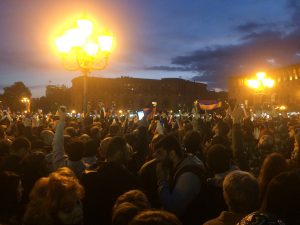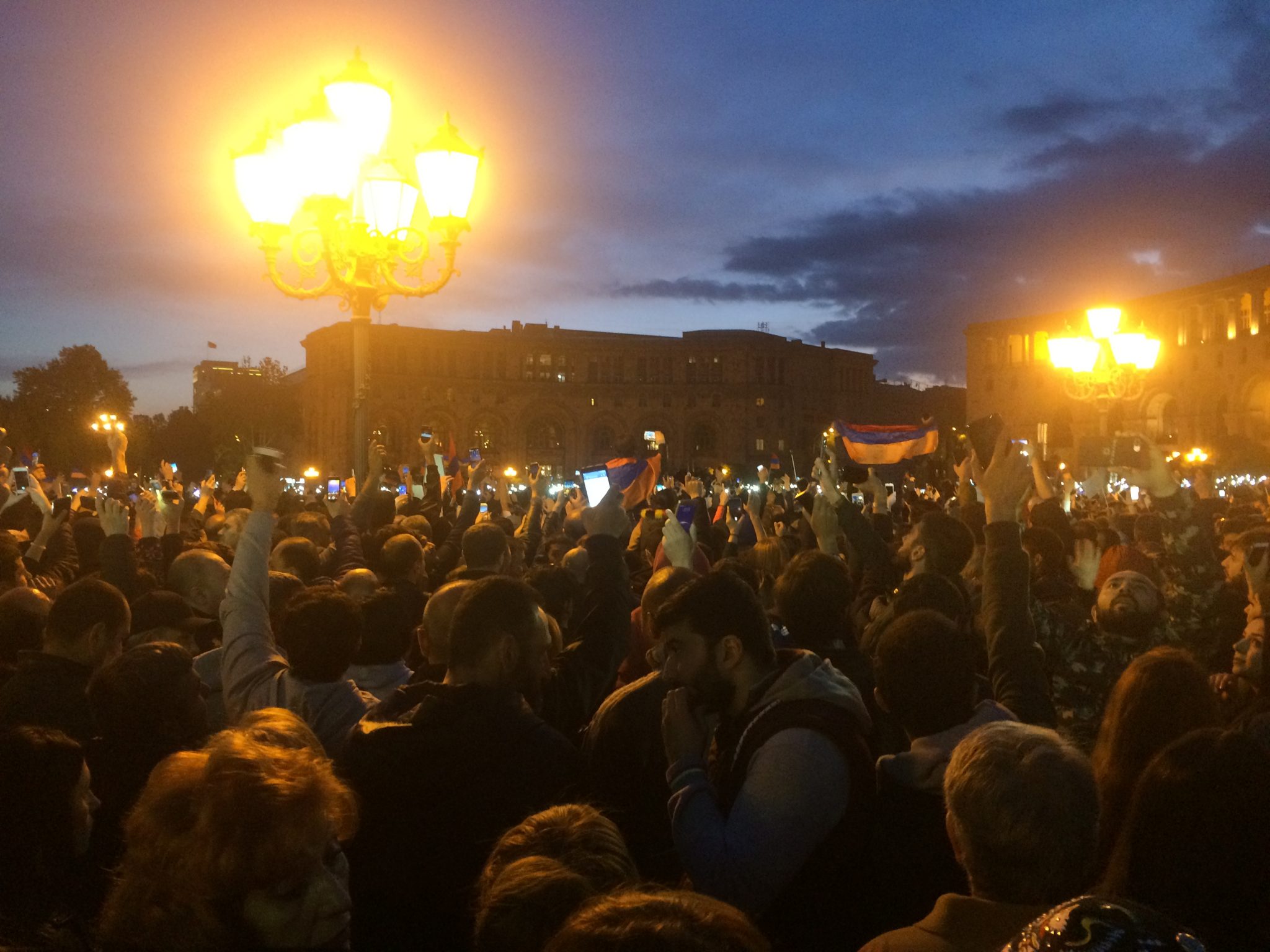by Dr Chiara Loda, IICRR scholar, tweets @ChiaraLoda
This post was originally published in the blog Presidential Power
April 2018 in Armenia was marked by massive grassroots protests, the resignation of the newly-nominated prime minister, and complex political negotiations.
Prime Minister Serzh Sargsyan, who formerly served as President for a decade, resigned on April 23, after 11 days of massive protests. While resigning, Sargsyan said: “Nikol Pashinyan was right. I was wrong.” MP Nikol Pashinyan, the head of the Yelk Bloc, emerged as the undisputed leader of these recent protests. On May 1, the failure of the National Assembly to nominate Mr Pashinyan as provisional Prime Minister has led to a new wave of intensified protests.
While most analysts were surprised by the resignation of Sargsyan and the beginning of a new political process, elements of continuity can be observed, both at domestic and international level. First, the grassroots protests against Serzh Sargsyan’s extended term in office were sudden, but can be traced back to December 2015, when a controversial constitutional reform was approved. Second, while Russia has taken a non-interventionist stance, all actors involved are fully aware of the importance of the “big brother”.
Some protests? Business as usual! (or not?)
Armenia is a peculiar case in the post-Soviet space. While Freedom House classifies the country as a “partly-free regime”, Armenians have often taken to the streets against unpopular provisions, such as the increase in bus fares in 2013, the pension reform in 2014[1], and the increase in electricity prices in Summer 2015 (known as ‘Electric Yerevan’). Against this background, it is not surprising that people closely scrutinised the manoeuvring of their political leaders.
In December 2015, following a referendum, a constitutional reform was approved[2]. As a result, most executive prerogatives were transferred from the President to the Prime Minister. While the promoters of this reform repeatedly remarked that a parliamentary system would prompt the full democratisation of the country, the public debate focused on whether this reform was an ‘ad-hoc’ mechanism to extend the rule of (then) President Serzh Sargsyan, who was serving his second and last presidential mandate. Rather than ending after the referendum, these allegations were the subject of further discussion, notably at the parliamentary election in 2017. Throughout this time, Serzh Sargsyan assumed an ambiguous position, neither confirming nor denying his intention to stay in power. In March 2018, when Sargsyan’s transition to the premiership seemed almost certain, MP Nikol Pashinyan announced that massive protests would follow any such development. He said: “If the people are decisive, and as many go onto the streets as on March 1, 2018, I guarantee that we will prevent the next reproduction of Sargsyan[3].”
On April 11, the ruling Republican Party (HHK) officially confirmed that Serzh Sargsyan would be nominated (and therefore elected) prime minister. While initially a limited number of people took to the streets, soon numbers added up, and thousands of people participated in the rallies, during which there were numerous clashes between the police and protesters. On April 22, after a meeting with the now prime minister Serzh Sargsyan, the protest leader Nikol Pashinyan and some of his closest associates were taken into custody. However, Mr Pashinyan was released the following day and shortly after Prime minister Serzh Sargsyan announced his resignation. As required by the law, the government resigned on the same day and first Deputy Prime Minister, Karen Karapetyan, was named acting PM.
However, the rallies did not stop, as Mr Pashinyan, backed by numerous supporters, aimed to become the provisional prime minister, so to supervise the preparation of free and fair elections. It was feared the ruling party HHK would manipulate any transitional process, by using administrative resources to reconsolidate their power.

On May 1, due to the opposition of the Republican Party, Pashinyan failed to be elected provisional Prime Minister. As things stand, a new parliamentary debate has been scheduled for May 8. As per the Armenian constitution, if the National Assembly is again unable to select a premier, this impasse would automatically lead to the dissolution of the legislature and snap elections. As a reaction, Pashinyan called for ‘Nationwide Civil Disobedience’. In the words of Pashinyan: “The peaceful revolution goes on (…) We’re not going to let them steal our victory”.
Nikol Pashinyan’s background is particularly remarkable. While other status-quo challengers in the region, first and foremost former President of Georgia Saakashvili, were previously Cabinet members[4], Pashinyan used to be a political prisoner. In 2010, he was sentenced to seven years for his role as an organiser in the anti-government protests of 2008. However, as a result of an amnesty, he was released the following year[5].
Big brother is (discretely) watching you
While the aforementioned dynamics are undisputedly domestic, all parties involved need to take into account the international environment, first and foremost Russia. As of 1999, Armenian foreign policy has been characterised by complementarity, which implies a diversified foreign policy within the leeway granted to it by Russia[6]. While some external observers have interpreted the protests as anti-Russian, Nikol Pashinyan, formerly known for his Russian-sceptic positions, has shown his awareness of the geopolitical constraints faced by his country.
When the protests started, some external observers said that they might be the prelude to an anti-Russian turn in Armenia. Former Georgian President Saakashvili, who framed the events as an anti-Russian uprising, unambiguously said that: “This is a very black day for Vladimir Putin. First, the West threatened him and imposed sanctions against him, hitting his oligarchs, and now they are squeezing the scope of his influence.” Similar comments were made by members of the Georgian parliamentary opposition[7]. Analogously, some Ukrainian media drew parallelisms between the current events in Armenia and the Maidan protests in 2014, which resulted in the ousting of the pro-Russian Yanukovych government[8]. For instance, journalist Ihor Solovey wrote that: “The street has won, and Russia has lost”, and therefore Serzh Sargsyan’s resignation should be understood as a “Russian foreign police failure“[9].
Despite this reading of events, Russian officials clearly refrained from making an alarmist comments, as if to emphasise that the Kremlin was not planning to interfere. Dmitry Peskov, the Kremlin spokesman, told journalists that Yerevan was: “Not going down the path of destabilisation“. Additionally, he specified that Russia hoped for: “Consensus among all the forces representing the Armenian people“. Similarly, Maria Zakharova, the Foreign Ministry spokeswoman, praised Armenia on Facebook for: “Not becoming divided, and maintaining respect for one another, despite definite disagreements“. Looking at the media coverage, Kremlin-friendly channels mostly ignored the events in Armenia until the resignation of Prime Minister Sargsyan and after that they commented on the festive attitude at the rallies. In some cases, it was openly said that the happenings in Yerevan were something completely different from Maidan[10].
This conciliatory attitude by Russia must not be confused with lack of interest. Russian officials and politicians made sure to keep their channels open with all the parties involved. On April 25, Putin had a conversation with Armenian President Armen Sarkissian. The same week, while Armenian Foreign Minister Edward Nalbandian met his Russian counterpart Lavrov, another meeting took place between some Russian diplomats and Nikol Pashinyan, who understands very well that a successful transition cannot happen without Russian support.
Previously, Nikol Pashinyan and his Yelk Bloc adopted clear Russo-sceptic positions. Notably, in Autumn 2017, they proposed a legislative initiative to the Armenian National Assembly which would have created a commission on withdrawal of Armenia from the Russian-led Eurasian Economic Union (EEU). According to Pashinyan, membership in the EEU harmed the growth of Armenia, as it restricted its opportunities for international trade[11]. Additionally, he also made security-related considerations, calling the deepening military ties between Armenia and Russia “humiliating”, just at the Kremlin was also reinforcing its military-strategic cooperation with hostile Turkey and Azerbaijan[12].
Despite these unequivocal declarations, the prospect of becoming Prime Minister has made Pashinyan play down his former Russo-sceptic attitude[13]. In the immediate aftermath of Serzh Sargsyan’s resignation, Pashinyan made it clear that the revolution was a domestic affair and that there was no geopolitical reversal on the agenda. Thus, during a press conference on April 24, Pashinyan declared that: “We’re not going to make any sharp geopolitical movements. We’re going to do everything in the interests of Armenia“. This point was made again, and emphasised, during a rally in Gyumry (April 27), where a Russian military base is located. On that occasion, Pashinyan bluntly said that: “We are no enemies to Russia,” and that he would not take Armenia “down the path of unwise [decisions] and adventures.”
Notes
[1] Loda, C., 2017. The European Union as a normative power: the case of Armenia. East European Politics, 33(2), pp.275-290.
[2] This blog has covered the constitutional reform as of 2015, analysing its details, the pre-vote dynamics, and the relevant debate in 2016 and 2017.
[3] ARMINFO News Agency. 2018. ‘In parallel with the reduction of the powers of the president of the country, his apparatus will be reduced’, March 7 (Retrieved through LexisNexis).
[4] BBC Monitoring Trans Caucasus Unit. 2016. “Armenian pundit eyes reasons, future of ‘velvet revolution’”, April 26 (Retrieved through LexisNexis).
[5] ARMINFO News Agency. 2011. “Nikol Pashinyan released”, 28 May (Retrieved through LexisNexis).
[6] Loda, C., 2017. The foreign policy behaviour of Armenia, Georgia and Azerbaijan (Doctoral dissertation, Dublin City University), p. 3.
[7] However, other Georgian politicians spoke about the importance to maintain good relations with Armenia, regardless of the recent development [BBC Monitoring Trans Caucasus Unit. 2018. “Some in Georgia see Armenian developments as blow to Russia”, April 24 (Retrieved through LexisNexis)].
[8] BBC Monitoring. 2018. “Former Soviet media view Armenian protests in Russian context”, 25 April (Retrieved through Lexis Nexis).
[9] BBC Monitoring Kiev Unit. 2018. “Ukrainian media hail victory of ‘Armenian Maidan’”, 24 April (Retrieved through LexisNexis).
[10] BBC Monitoring. 2018. “Former Soviet media view Armenian protests in Russian context”, 25 April (Retrieved through Lexis Nexis).
[11] “Armenian National Assembly discusses legislative initiative on withdrawal from EEU”, 3 October (Retrieved through LexisNexis).
[12] ARMINFO News Agency. 2017. “Hot debates in Armenian Parliament over creating the United Group of Armenian-Russian troops: Block Yelk considers the document humiliating and “vassal””, 4 October (retrieved through LexisNexis).
[13] Providing a full account of the Russo-Armenian relationship/dependency goes beyond the scope of this post. For more insights, refer to: Loda, C., 2017. The foreign policy behaviour of Armenia, Georgia and Azerbaijan (Doctoral dissertation, Dublin City University),


